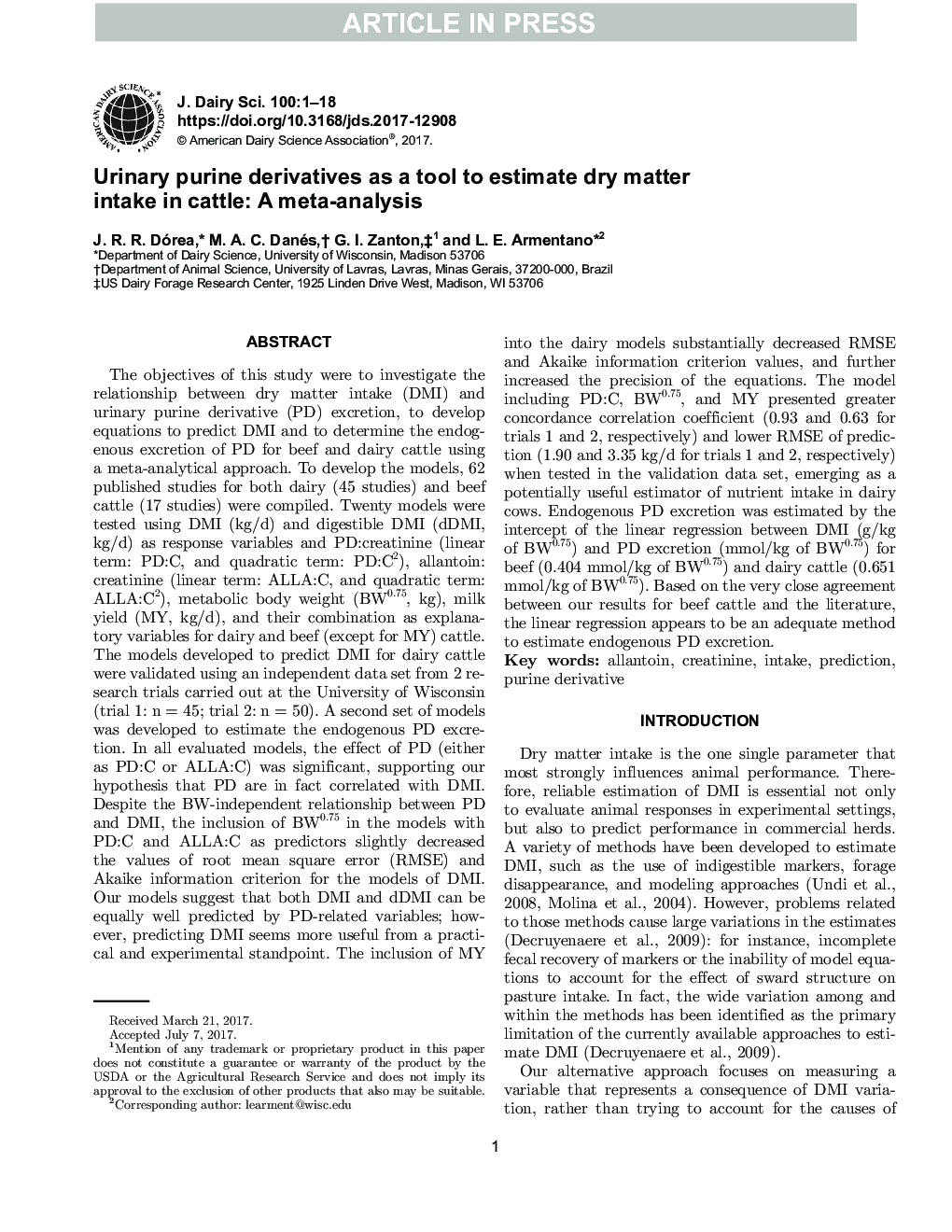| کد مقاله | کد نشریه | سال انتشار | مقاله انگلیسی | نسخه تمام متن |
|---|---|---|---|---|
| 5541667 | 1553846 | 2017 | 18 صفحه PDF | دانلود رایگان |
عنوان انگلیسی مقاله ISI
Urinary purine derivatives as a tool to estimate dry matter intake in cattle: A meta-analysis
ترجمه فارسی عنوان
مشتقات پورین ادرار به عنوان ابزار برای برآورد میزان مصرف ماده خشک در گاو: یک متاآنالیز
دانلود مقاله + سفارش ترجمه
دانلود مقاله ISI انگلیسی
رایگان برای ایرانیان
کلمات کلیدی
آلتوئین، کراتینین مصرف، پیش بینی، مشتقات پورین،
موضوعات مرتبط
علوم زیستی و بیوفناوری
علوم کشاورزی و بیولوژیک
علوم دامی و جانورشناسی
چکیده انگلیسی
The objectives of this study were to investigate the relationship between dry matter intake (DMI) and urinary purine derivative (PD) excretion, to develop equations to predict DMI and to determine the endogenous excretion of PD for beef and dairy cattle using a meta-analytical approach. To develop the models, 62 published studies for both dairy (45 studies) and beef cattle (17 studies) were compiled. Twenty models were tested using DMI (kg/d) and digestible DMI (dDMI, kg/d) as response variables and PD:creatinine (linear term: PD:C, and quadratic term: PD:C2), allantoin:creatinine (linear term: ALLA:C, and quadratic term: ALLA:C2), metabolic body weight (BW0.75, kg), milk yield (MY, kg/d), and their combination as explanatory variables for dairy and beef (except for MY) cattle. The models developed to predict DMI for dairy cattle were validated using an independent data set from 2 research trials carried out at the University of Wisconsin (trial 1: n = 45; trial 2: n = 50). A second set of models was developed to estimate the endogenous PD excretion. In all evaluated models, the effect of PD (either as PD:C or ALLA:C) was significant, supporting our hypothesis that PD are in fact correlated with DMI. Despite the BW-independent relationship between PD and DMI, the inclusion of BW0.75 in the models with PD:C and ALLA:C as predictors slightly decreased the values of root mean square error (RMSE) and Akaike information criterion for the models of DMI. Our models suggest that both DMI and dDMI can be equally well predicted by PD-related variables; however, predicting DMI seems more useful from a practical and experimental standpoint. The inclusion of MY into the dairy models substantially decreased RMSE and Akaike information criterion values, and further increased the precision of the equations. The model including PD:C, BW0.75, and MY presented greater concordance correlation coefficient (0.93 and 0.63 for trials 1 and 2, respectively) and lower RMSE of prediction (1.90 and 3.35 kg/d for trials 1 and 2, respectively) when tested in the validation data set, emerging as a potentially useful estimator of nutrient intake in dairy cows. Endogenous PD excretion was estimated by the intercept of the linear regression between DMI (g/kg of BW0.75) and PD excretion (mmol/kg of BW0.75) for beef (0.404 mmol/kg of BW0.75) and dairy cattle (0.651 mmol/kg of BW0.75). Based on the very close agreement between our results for beef cattle and the literature, the linear regression appears to be an adequate method to estimate endogenous PD excretion.
ناشر
Database: Elsevier - ScienceDirect (ساینس دایرکت)
Journal: Journal of Dairy Science - Volume 100, Issue 11, November 2017, Pages 8977-8994
Journal: Journal of Dairy Science - Volume 100, Issue 11, November 2017, Pages 8977-8994
نویسندگان
J.R.R. Dórea, M.A.C. Danés, G.I. Zanton, L.E. Armentano,
